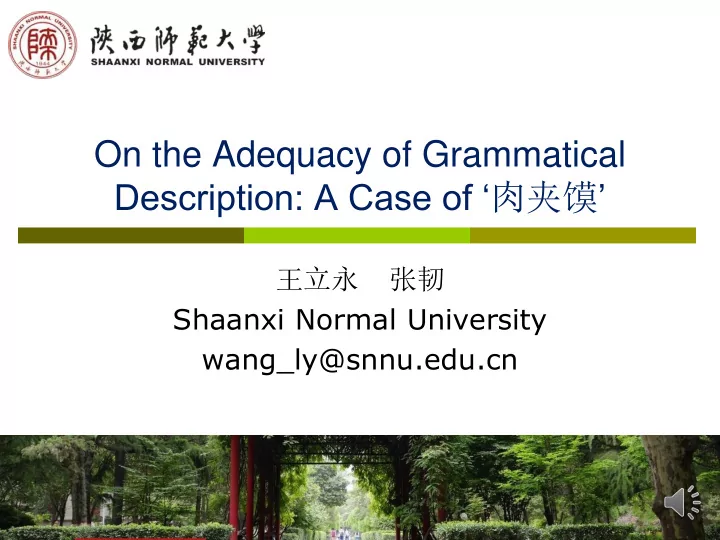

On the Adequacy of Grammatical Description: A Case of ‘ 肉夹馍 ’ 王立永 张韧 Shaanxi Normal University wang_ly@snnu.edu.cn 1
Content 1. The issue 2. Disputes on structural analysis 3. Cognitive Grammar account of linguistic knowledge 4. A CG account of ‘ 肉夹馍 ’ 5. Conclusions 2
Content 1. The issue 2. Disputes on structural analysis 3. Cognitive Grammar account of linguistic knowledge 4. A CG account of ‘ 肉夹馍 ’ 5. Conclusions 3
The grammatical nature of compounds Lexical approach ◼ Syntactical rules and lexical rules are independent (Selkirk 1982; DiScilullo & Williams 1987) Syntactic approach ◼ Syntax all the way down (Marantz 1984; Baker 1988) 4
The case of Chinese deverbal compounds Some examples ◼ (1) a. 汽车修理工( car repair worker ‘car mechanic’ ) b. 纸张粉碎机( paper shred machine ‘paper shredder’ ) c. 论文指导教师 (thesis supervise teacher ‘thesis superviser ’) 5
Structural derivations 顾阳 & 沈阳 (2001) 6
程工 & 周光磊 (2015) 7
Objections to structural derivations Two objections ◼ 1. Structural knowledge is always required in the processing of compounds ◼ 2. Speakers have different perceptions of compounds with identical structures In a nutshell, structural derivations fail to capture the speakers’ linguistic knowledge, a violation of descriptive adequacy (Chomksy 1965) 8
The present analysis Based on the structural disputes centered around the compound ‘ 肉夹馍 ’, the present paper argues for a Cognitive Grammar account of the nature of linguistic knowledge ◼ Linguistic knowledge consists in networks of constructions stored in the brain ◼ The licensing of linguistic expressions are not mere computation of rules but involve the motivation of constructions in the network 9
Content 1. The issue 2. Disputes on structural analysis 3. Cognitive Grammar account of linguistic knowledge 4. A CG account of ‘ 肉夹馍 ’ 5. Conclusions 10
‘ 肉夹馍 ’ ( meat sandwich pancake ) “Oddness” of this word ◼ What one sees: pancakes sandwiches the meat ( 馍 夹肉 ) ◼ What the surface structure of the word tells: the meat sandwiches the pancake ( 肉夹馍 ) 11
Folk explanations Preposition omission analysis ◼ ‘ 肉夹 ( 于 ) 馍 ’ ( meat sandwich prep. pancake ‘meat is sandwiched in pancake’ ) Objections ◼ 1. Does not observe the naming habit ◼ 2. The hypothesized full name never appears 12
Folk explanations The avoidance of homonymy hypothesis ◼ ‘ 馍夹肉 ’ ( pancake sandwich meat ) sounds like ‘ 没夹 肉 ’ (no sandwich meat) in Shaanxi dialect Objection ◼ Cannot be extended to compounds with identical structures, e.g. 油条卷饼 (‘oil stick roll pie’) 13
The right structural analysis ‘ 肉夹馍 ’ as ‘N+VN’ compound ( e.g. 李晋霞 2008; 杨锡彭 2012 ) ◼ (2) 菜( vegetable )夹馍 , 鸡蛋 (egg) 夹馍 , 辣子 (pepper) 夹馍 , 土豆 (potato) 夹馍 … 肉夹馍 N N V N 肉 夹 馍 14
The right structural analysis This makes ‘ 肉夹馍 ’ no different from the following compounds with the pattern ‘X 炒饭 (stir- fried rice)’ ◼ (3) 蛋 (egg) 炒饭 , 肉 (meat) 炒饭 , 香菇 (mushroom) 炒饭 , 火腿 (ham) 炒饭 蛋炒饭 N N V N 蛋 炒 饭 15
Two neglected observations First, no structural knowledge is required in order for speakers to understand and use the compound ‘ 肉夹馍 ’ Second, of the two types of compounds represented by ‘ 肉夹馍 ’ and ‘ 蛋炒饭 ’, only the former arouses structural confusion 16
Any descriptively adequate account of compounds accurately should reflect the above observations! 17
Content 1. The issue 2. Disputes on structural analysis 3. Cognitive Grammar account of linguistic knowledge 4. 肉夹馍 in the network of constructions 5. Conclusions 18
Constructions Constructions as basic elements of linguistic knowledge ◼ “A construction is defined as either an expression (of any size), or else a schema abstracted from expressions to capture their commonality (at any level of specificity)…… They [expressions and schemas] constitute established units” (Langacker 2003: 43) 19
Constructional networks Linguistic knowledge is organized in the form of networks of constructions Langacker 2008 : 226 20
Content 1. The issue 2. Disputes on structural analysis 3. Cognitive Grammar account of linguistic knowledge 4. A CG account of ‘ 肉夹馍 ’ 5. Conclusions 21
‘ 肉夹馍 ’ as an established linguistic unit 1. ‘ 肉夹馍 ’ stored as an independent construction 22
‘ 肉夹馍 ’ as an established linguistic unit 2. Shows low degree of analyzability, like many constructions ◼ flinger > complainer > computer > propeller > drawer (Langacker 2009: 27) 23
‘ 肉夹馍 ’ in the network of constructions 1. Confusion of ‘ 肉夹馍 ’ with ‘馍夹肉’ The actual situation, coupled with the conceptual meaning of the verb ‘ 夹 ’, gives rise to the structural confusion. 24
‘ 肉夹馍 ’ in the network of constructions 2. Difference between’ 肉夹馍 ’ and ‘ 蛋炒饭 ’ ◼ Why does only the former arouse structural confusion? ◼ Hypothesis: related to the conceptual nature of relevant verbs 25
Meanings of the verb ‘ 夹 ’ (sandwich) ◼ (4) a. 父亲轻轻地叹了口气,然后又夹了块肉送到我的碗里,声音 有些喑哑地说:“吃吧,过年哩。”(国家语委语料库) b. 那女孩望着他,红红的指头夹着一个便士,向他高高举起。 Ag. 肉 馍 26
Meanings of the verb ‘炒’ (stir-fry ) ◼ (5) a. 王家斌的老伴不能亲自做饭,便躺在炕上指挥着女儿,为我 炒了盘鸡蛋,砸了蒜末,炸了辣椒油,下了挂面。 b. 一看,原来都在猪身上打滚 -- 豆牙炒肉丝,荸荠炒腰花,莴 苣 烧肚片,萝菔炖肉。 豆 芽 Ag. 肉 丝 27
‘ 肉夹馍 ’ in the network of constructions 3. ‘ 肉夹馍 ’ in the constructional network 28
Merits of the present analysis Compared with previous rule-based accounts, the present analysis not only ◼ Explains the structural composition of compound words But also ◼ Captures the speakers’ knowledge of compound words 29
Content 1. The issue 2. Disputes on structural analysis 3. Cognitive Grammar account of linguistic knowledge 4. A CG account of ‘ 肉夹馍 ’ 5. Conclusions 30
Conclusions Rule-based accounts cannot fully describe the speakers’ knowledge of linguistic expressions The licensing of linguistic expressions involve the motivation by a complex network of constructions (Taylor 2004) 31
References Omitted 32
Thanks! 33
Recommend
More recommend